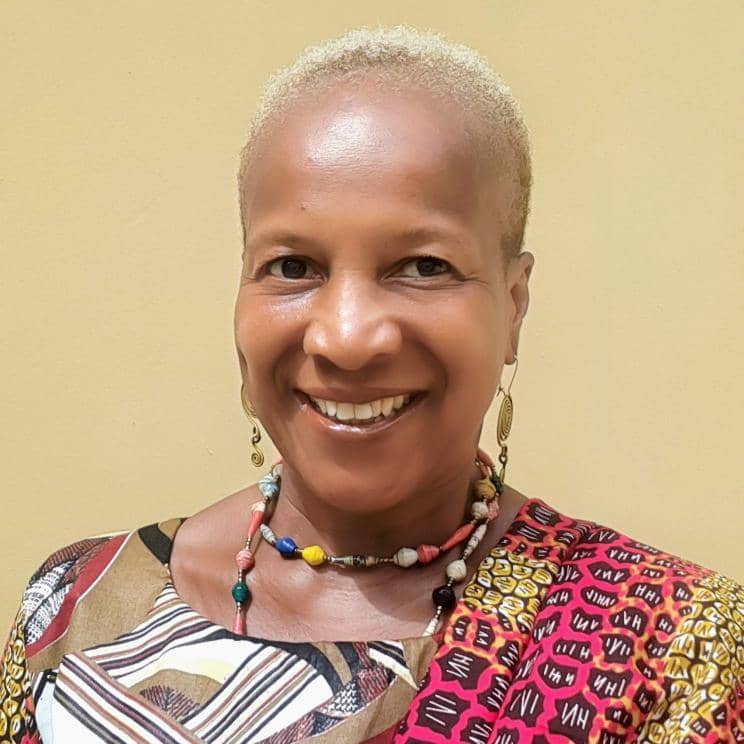With my backpack tossed aside and my stomach grumbling, I made my way to the kitchen to participate in one of my most cherished pastimes: gorging myself with Nigerian food. I was in high school and after a long day of school and extracurricular activities, I appreciated coming home to my family around the dinner table. As we filled our empty stomachs with garri and soup, the television in the living room diagonal to our table flickered with images of Africans just like us, except their stomachs were swollen mounds balanced on their emaciated bodies.
Flies surrounded their young faces as mucus dripped from their nostrils like molasses. The white American lady beside these impoverished African children ambled toward the camera saying something along the lines of, “For just a dollar a day, you can provide food for this young African child for thirty days.”
My father quickly collected the remote nearby, expressing his displeasure at what he saw. Here he was: a Nigerian immigrant whose only representation in mainstream media were these sad depictions of people from the African continent. To the average American, he was once that poor African child on the brink of death. My whole family was that poor African child. After all, in the United States, Africans are not afforded nuance. We are a monolithic people, and the 1.033 billion Africans that live on this planet are viewed from this repetitive, sobering image of poverty and disease.
As a Nigerian-born Canadian living in the United States, I am legally identified as an immigrant. But socially, I found that my immigrant status is mostly non-existent here.
My Nigerian identity is often tucked messily inside of my ‘Canadimerican’ accent, and my foreignness is usually hidden as long as I move about this American soil with Western clothing on my body. And I do often.
But when I hear the experiences of black immigrant friends and family living outside of their native lands, their accents also reflective of their new home, their foreignness is more pronounced. For instance, in the UK, their immigrant status was not contingent upon the accent on their tongue or the clothes on their back. Their skin tones, broad noses, thick lips and other features that racialized them as black were enough to label them ‘foreigner’ and thus ‘immigrant’ or at least the child of one (or ‘refugee’ if they were fleeing their country to escape war, persecution, etc.). This is also true of just about every black immigrant living in Canada, Australia, or any other mostly white populated Westernized country; it is assumed you are first or second, and sometimes third generation in that country. But in the United States, things operate a bit differently to say the least.
I was reminded of this difference when I had a conversation with a black American friend of mine via text several months ago. We were talking about how our geographical backgrounds have played into the ways we speak English.
After I shared a bit of my background, she said, “I’m so jealous that you know where you’re from in Africa. That you were born there and you know your roots. That must be amazing.” I remember being stunned when she wrote that, stunned at the realization I take the knowledge of my African lineage for granted.
I was also reminded that, during the transatlantic slave trade, not only were African people taken from their land against their will, but they had their identity stolen from them as well. With each successive generation born in the United States, their ethnic, tribal identities faded away as white supremacy continued to establish itself. Over time, ‘black’ or ‘African American’ became the most popular identifiers for the African Diaspora in the United States, though the debate concerning how they should identify themselves continues to this day.
Fast forward to the 20th century and blackness has been part of the United States’ history for nearly three hundred years. At this same moment in history, the influx of black immigrants has begun. One of the most notable examples of this migration is seen in New York City in the early 1900s, with the iconic destination being the new home for many West Indian and Afro-Latin immigrants. Upon entering the United States, their professions encapsulated many fronts, from education to domestic work to the service sector. Later on in the 20th century, the majority of Caribbean people who came afterwards came to join their family already living in the U.S. Fast forward towards the end of the 20th century and the boom of African emigration to America begins. With the continued pouring in of black immigrants from various parts of the world, the concept of living as a black person in the United States inevitably becomes all the more nuanced.
Despite the growth in the black population and complexity of living as a black person in 21st century United States, it can be tempting to chalk up the overall invisibility of black immigrant narratives in mainstream media to the fact we are small in number compared to other people groups. However, if you take a harder look, black immigrants are definitely visible. For example, one of the most notable facts about United States’ President Barack Obama is he is the son of a Kenyan immigrant. Rihanna and Nicki Minaj, both chart-climbing performers and entertainers in the U.S, hail from Barbados and Trinidad respectively.
Just about everyone who knows an African immigrant knows them to be educated professionals as they rank as the most educated in the U.S. immigrant population. In a number of major cities nationwide, there are celebrations that showcase the culture and traditions of different black immigrants. Despite black immigrants being a minority, we are far from being inaccessible to your everyday American. But even with this accessibility, the basic grasp of living as a black immigrant is very much absent from the knowledge of everyday Americans. A look at the reception of Rihanna’s new music this year is a great example of this.
When Rihanna released her chart-climbing single, Work, the only critique I gave was my hips swaying in approval. While this tune became one of my personal favorites from her, I quickly noticed how it became a punchline for many others. Throughout social media, memes and videos reducing her lyrics to lexiconic nonsense were shared by Americans across various racial lines, and I found myself disappointed at this shameless display of ignorance. Where many heard ‘gibberish’, I heard echoes of home; her song used the patois from her Caribbean home and it subtly reminded me of the Nigerian pidgin I would use when talking with my Nigerian friends.
Many times, people forget I’m Nigerian after I introduce myself as Nigerian; I blame my Americanized accent for this. But when a woman like Rihanna has an accent so obviously foreign to the U.S, I figured more people would connect her patois in her music to her foreignness, even if they didn’t know which country she was from. Just about everybody knows foreigners enjoy playing music that reflects where they come from. From that, it can be easily inferred that artists whose origins go beyond the United States would bring pieces of their culture inside their music; black immigrants are obviously no exception. But unfortunately, the ability to exercise such thinking was missed by many Americans.
The United States is unfortunately stereotyped to be a culturally ignorant nation. With the increase of information of marginalized people including black immigrants, one would expect the knowledge about such people groups would noticeably increase. But that is not the case. The problem is not the access to the marginalized stories. The problem is the stories have not been read and amplified to the point of significantly changing mainstream American media.
It’s not that the complexity of the black immigrant experience is out of reach. The problem is so few people have begun to grasp it, greatly contributing to the monolithic lens by which we view black immigrants.
Given that the majority of platforms that showcase minorities are independent of mainstream media powerhouses, bringing these stories closer to the focal point of the United States’ narrative is up to the consumer. We have the ability not only to consume knowledge and stories, but to amplify them by word of mouth and with the power of social media. The visibility of black immigrant narratives in all their complex glory grows with amplification. The voices have always been here. It’s just up to us to listen to them and magnify them.
This post originally appeared in The Black Expat on 10 January 2017
Mary Bassey is a Nigerian-Canadian-American with an overactive mind and an obsession with words. She holds a Bachelor’s Degree in Biochemistry and she loves performing music, both vocals and instrumentals. You will probably find her dancing to her favourite deep house tracks or curling up reading books that stimulate her curiosity. She’s also a fan of Sunday afternoon naps.
The Other Expats community welcomes voices from many spheres. We publish pieces written by outside contributors with a wide range of opinions, which don’t necessarily reflect our own. Learn more or join us as a community member.









